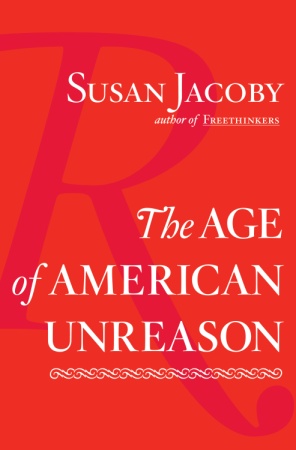
The Age of American Unreason
by Susan Jacoby
Despite the prevalence of trashy TV, eye-glazing video games, dumbed-down political discourse, the “ersatz conversation” of email, and the ubiquitous statistics on how little we know about anything, Susan Jacoby knows that American anti-intellectualism is not a wholly new phenomenon. In her survey of modern anti-intellectualism and anti-rationalism, Jacoby starts with a thorough, densely researched history of their roots in early America and their flourishing in the last century, with the anti-communism of the 1950s and the triumphant youth culture of that most discussed, most maligned decade, the 1960s. Our current woes, it seems, began long before there were bloggers snarking about John Kerry’s cosmopolitanism or defending Sarah Palin’s inability to name more than one Supreme Court case.
Take the Gilded Age theory of social Darwinism (not so named then, however), the insidious claim made by faux intellectuals that successful people were more highly evolved than their more hapless fellow Americans. Such an extension of Darwin’s theory of evolution, Jacoby notes, was patently unproved by science and never endorsed by Darwin (just the opposite, in fact). But that didn’t stop it from being touted around the country and linked to Darwin’s legitimate scientific theory, already a sticking point for religious fundamentalists.
In that early example of “junk science” lay the blueprint for much of what plagues our modern state of unreason, Jacoby argues. Social Darwinism was “the first mass-marketed wave of pseudoscience” – made possible by advancing publishing technology, the invention of the “lecture circuit,” and proponents willing to fake authoritativeness by dressing their conjectures and biases in scientific-sounding language.
Today’s “junk science” and “junk thought” (Jacoby’s coinage) – the disbelief in global warming and evolution, the fear that girls’ success somehow means boys’ failure, and the triumph of dumbed-down culture – is similarly made possible by mass media and political leaders. The difference, to Jacoby, is the omnipresence of today’s media, the politicized distrust of intellectuals, the cementing of youth and celebrity culture, and more entrenched religious fundamentalism. Jacoby charts these trends, hitting popular targets – iPods and iPhones, chick lit, e-mail exchanges and video games – along with tougher marks, like the country’s poor education system.
In her critique, Jacoby refuses to spare the right or the left or the center. Nor does she spare intellectuals, who, she says, use anti-intellectualism to tarnish intellectuals who disagree with them, and who can be dangerous when they are too close to power: “One can only wish that Bill Kristol, instead of being received respectfully at the White House as an expert on foreign affairs, was, like his father, a New York intellectual whose fulminations circulated mainly among other New York intellectuals and never attracted the attention of anyone with the power to implement his ideological schemes.” Jacoby excels at this sort of unabashed, erudite putdown, and she surely wishes she could see such remarks in online comment boards on Kristol’s (and her own) writing. Instead, she’s mostly left with the “peculiar punctuation and solipsistic tone” of unashamed outbursts and rants, part of the unending din of our “culture of distraction,” from which her book is, at least, a brief and not entirely pessimistic departure.
Excerpt: “Anti-rationalism and anti-intellectualism flourish in a mix that includes addiction to infotainment, every form of superstition and credulity, and an educational system that does a poor job of teaching not only basic skills but the logic underlying those skills.”
Further reading: Anti-Intellectualism in American Life and The Last Intellectuals




Send A Letter To the Editors